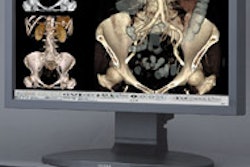These days the American dream means more than having a job and owning a home. Some have set their sights on the idea of earning a solid professional income from home. And while a highly paid career at home is still a tall order for most people, it is becoming an increasingly common reality for radiologists.
Today a new breed of radiologists has found an alternative to traditional medical group, hospital-based, or solo practice. Known as "remote" radiologists, these physicians read studies at home from remote locations across the state and beyond.
It's common for radiologists to take call from home using teleradiology to provide coverage for their local group or hospital. Remote radiologists are different, however, because they generally are not part of a local group or hospital. They work solo, and while they may provide reads to some local entities, they primarily receive studies from multiple locations that are not in their communities or even in their states. In essence, remote radiologists practice on a locum-tenens basis. But instead of traveling to various states to work, work from various states comes to them.
This form of practice has several attractions. For one, it affords radiologists the opportunity to enjoy fee-for-service reimbursement. Remote radiologists generally are paid per study, and usually do not have to deal with third-party payers or the hassles of managed medicine. They also are immune from the strain of group or hospital politics. Remote radiology can be a good alternative for radiologists who need to be at home for family or other personal reasons, or for those who simply enjoy an environment that is relatively free of distractions.
But remote radiology isn't for everyone. Radiologists thinking of embracing this form of practice should carefully review what it entails, weighing the positives against the negatives. Questions to consider include:
How do I get work? There are two options: You can be your own marketer and bring in contracts with hospitals, medical groups, and other organizations needing radiology coverage yourself, or associate with a remote teleradiology firm. These firms work something like locum-tenens agencies, though in general they are more "hands-on." They schedule radiologists to cover various hospitals, medical groups, and other facilities that need additional night, weekend, or even daytime interpretations. Full-service firms help install and maintain the necessary equipment, assist with licensure and credentialing, and provide malpractice insurance. In exchange, remote radiologists split their per-study reimbursement with the firm.
The benefit of working on your own is that you have complete control of what hospitals or medical groups you will work with and when you will work. You also can keep all the reimbursement you earn. This model can work well for entrepreneurial radiologists who have extensive professional contacts, who are adept at managing their time, and who are financially positioned to weather some "ramp-up" time until their remote practice gets going. Radiologists who prefer to focus on clinical aspects of practice may be more suited to working with a remote teleradiology firm. Again, this mirrors the locum-tenens model in which some physicians act as their own "agents" and others prefer to work with agencies.
Should I work day or night? Due to the shortage of radiologists, daytime work has become more common, as an increasing number of hospitals and groups require extra coverage during the day. Some hospitals have even gone entirely remote, and have no radiologists onsite, except for when the occasional invasive procedure is performed. The majority of work for remote radiologists, however, still occurs at nights or on weekends as groups and hospitals seek to maintain 24-hour, 365-day-a-year radiology coverage. Most night and weekend work entails covering the emergency department.
In addition to being easier to come by, night and weekend work reimburses at a higher rate than daytime work. Also consider that remote radiologists working nights provide preliminary reads, while those working in the day provide definitive reads. Image resolution needs to be higher for remote radiologists reading during the day because they are providing final reports. This usually requires more sophisticated and more expensive equipment. The great majority of studies generated at night -- somewhere in excess of 95% -- are CT or ultrasound, whereas daytime studies usually are composed of all types of modalities. Night shifts vary anywhere from late afternoons to the early morning hours, or they may begin late at night and extend to six or seven in the morning. Radiologists need to weigh all these factors before deciding whether daytime or nighttime work is the best option.
What are the malpractice implications of working remotely? I strongly advise remote radiologists not to rely on a standard state policy, but to purchase a policy that specifically covers teleradiology. This is particularly true for those who are providing coverage to out-of-state hospitals or medical groups. These policies are somewhat more expensive than regular policies are, and can be more difficult to find -- some remote radiologists have to go through Lloyd's of London to obtain them. However, because the policies are tailored to teleradiology, they offer a significantly higher level of security to remote radiologists than regular ones do.
What about licensure and credentialing? The rule of thumb here is not to underestimate the time and effort it takes to get credentialed. Since the Joint Commission on Accreditation of Healthcare Organizations (JCAHO) started frowning on temporary credentialing as employed in the locum-tenens industry, the credentialing process now takes as long as obtaining licensure. If you choose to work as your own agent, you may wish to contract with a firm that assists physicians with credentialing. If you work with a remote radiology firm, be sure to select one that has an experienced credentialing department. It also will help your marketability to be licensed in a number of states. Keep in mind that some states have 10-year recertification requirements, and that the average licensure fee is around $1,200.
What type of income can I expect? In our experience, a remote radiologist working full-time -- meaning 26 weeks a year -- will typically earn between $400,000 and $600,000 per year. This is provided that the radiologist is working an exclusively nighttime schedule. A daytime remote radiologist practicing full time will work about 45 to 50 weeks a year, and will typically earn in the $250,000 to $300,000 range due to lower daytime reimbursement. In both cases, this assumes that the radiologist is able to maintain a full work schedule, either obtaining clients on his or her own, or working through a remote teleradiology firm.
While remote radiology clearly will not replace traditional radiology as a style of practice any time soon, it provides an interesting alternative that radiologists may wish to consider. It also reflects the rapid changes that are taking place in healthcare delivery today.
By Mark Bakken
AuntMinnie.com contributing writer
December 21, 2004
Mark Bakken is co-founder of The Radlinx Group, an Irving, TX-based national remote teleradiology firm. He can be reached at [email protected].
Related Reading
Telerad services solve problems, generate revenue, December 1, 2004
Radiologists are hot, but no longer red-hot, July 26, 2004
Survey predicts big loss of practitioners to retirement, changing work patterns, December 23, 2004
Salary offers to radiologists jump 11%, July 14, 2003
Radiologists tough to recruit, survey finds, February 25, 2003
Copyright © 2004 AuntMinnie.com



















